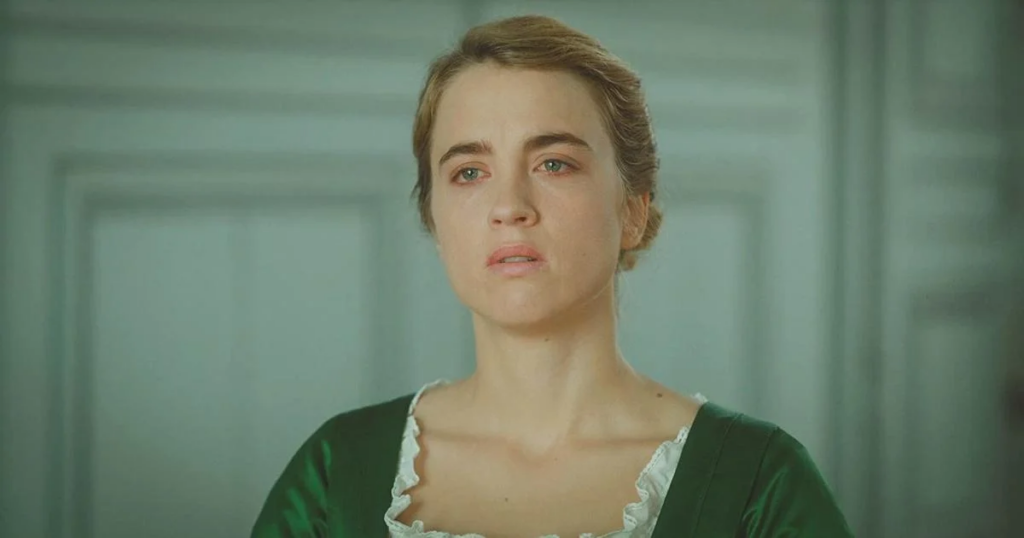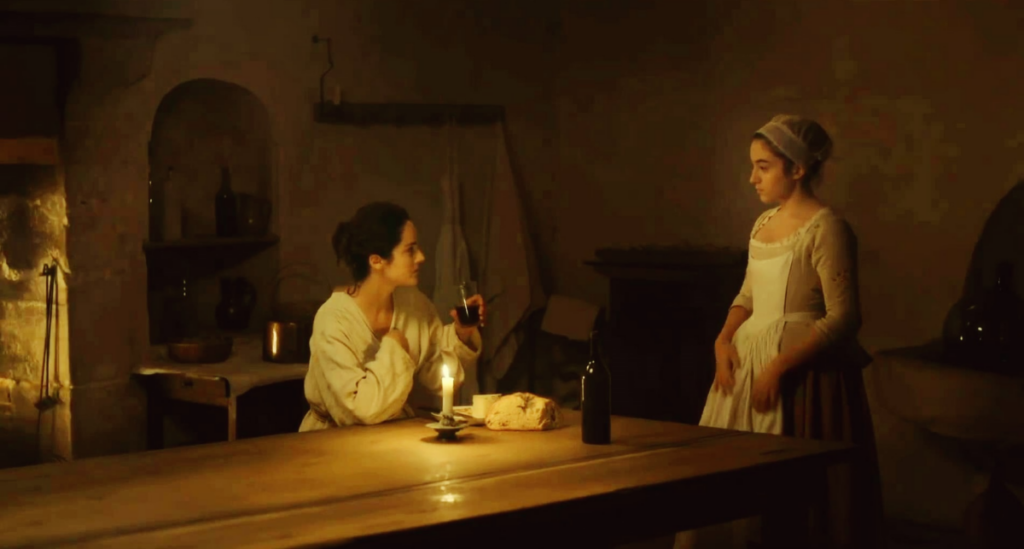When Marianne is teaching her painting class at the start of the film, I realized that Portrait of a Lady on Fire was a story, similar to the Grand Budapest Hotel, told by memory. We are seeing Héloïse through what Marianne remembers of her. I believe that cinematographer Claire Mathon conveyed these details of memory through the focus of the camera as well as the framing of the characters. Throughout the film, characters are placed within the center of the frame, while also being the primary focus of the camera. When looking at one character closely, the background becomes blurry directing the viewer to examine the face:

I believe this more shallow depth of field is an intentional choice, to show the way a character’s memory works. While they remember the details of the background, the thing that is primarily focused on is the face of the person (in this case, Héloïse’s face).
Claire Mathon uses long shots when the women walk around on the island but as the film continues, she also utilizes use more close-ups showing the intimacy between the two characters. These close-ups help to create a way in which the viewers can to feel the character’s emotions more closely. I also felt the way that long shots looked (specifically the outdoor ones) were visually stunning (as shown below), and was curious as to why she picked to use these extreme long shots.

The way the camera moves with the characters, specifically during the long takes, also reflects the memory of Marianne while making the film feel more realistic. As a viewer, I was able to feel as though I was more immersed with the characters (due to lack of cuts) and inside of this loving yet tense environment this film takes place in. In addition to this, I feel that the straight-on angle of the camera also makes the viewers feel as though they are there with these women. A high or low shot would change the impression of these scenes and would remind us that we are watching a film, taking viewers out of the closeness of their relationship. The lighting also played an important role; much of the lighting was diegetic. Coming from candles or fire, this kind of lighting made the scenes have a much more soft and loving tone, but also continued with the idea of realism, as this movie was set in the late 18th century.

However, I was still left wondering what the fire meant in this film. In many of the shots, the fire is located in the background, with an obvious exception being, when Héloïse gets her dress set on fire. I considered the idea of fire representing the passion of their relationship however I felt that there is more to the idea.
I really like the points you made about the shallow depth of field allowing the viewer to become immersed in the film and memories of Héloïse through Marianne’s perspective. As you mentioned, the blurred background allows the primary focus to center on Héloïse which I found very reminiscent of the way a painter studies their subject. By focusing so intensely on Héloïse, everything else naturally fades into the background, just as a painter blurs the surroundings to truly capture the essence of their subject. Marianne’s prolonged gaze mirrors the way an artist’s concentration causes all other details to recede, allowing her to study Héloïse with a heightened sense of intimacy and precision.
As for the fire in the film, I interpreted it as a symbol of the fleeting nature of the love between the artist, Marianne, and muse, Héloïse. Even though their relationship felt like they’d known each other for years, in reality, they only had two weeks together, and like fire, their love was intense but brief. Fire is also dangerous, adding a further layer to the symbolism that their love could burn them both since it is forbidden in society at the time the film takes place.
As for Héloïse setting on fire, she appeared completely serene when she finally noticed and didn’t even move to put it out herself, it was Sophie who came running to extinguish it. I thought of that as Héloïse fully opening herself up to Marianne’s love since in the next scene they go down to the cliffs and kiss for the first time, again solidifying that the fire we see in the film is symbolic of the fire burning within each of the women.
I agree that the fire could represent the passion in their relationship. Specifically, I interpreted the fire in the background as a way to symbolize both of the women keeping their attraction for each other a secret, which is why the fire being in the foreground happened right before they decided to act on their feelings. I think this is also supported by the women smoking a pipe together in one of their first interactions because they had a very hidden attraction at that point, pipes have smoke, and where there’s smoke, there’s fire. Moreover, in the scene where Marianne burns the first portrait of Heloise, she starts the fire at the heart, which could have been a representation of her hoping that Heloise felt the same, or of her knowing Heloise felt the same and knowing that they would only be able to fall in love when they were alone, and knowing that their love could “burn” them, or leave a lasting mark on both of them.